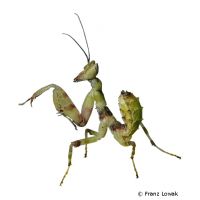Asian Flower Mantis (Creobroter elongata)
| Asian Flower Mantis Creobroter elongata | |
|---|---|
| Name | Asian Flower Mantis |
| Name Lat. | Creobroter elongata |
| Family | Flower Mantids |
| Family lat. | Hymenopodidae |
| Order | Praying Mantids |
| Order lat. | Mantodea |
| Origin | Asia |
| Habitat | Shrubland |
| Diet | Flying insects |
| Humidity | 50-70 % |
| Behavior | Predatory |
| Keeping | Individual |
| Care Level | Easy |
| Housing | Semi humid terrarium |
| Breeding | Moderately difficult |
| Life Span | 3-6 months |
| Protection | No |
| Metric Units | |
| Size | 4.5 cm |
| Temperature Day | 25-30 °C |
| Temperature Night | 20-22 °C |
| Housing Size | 20 x 20 x 30 cm |
| US Units | |
| Size | 1.8" |
| Temperature Day | 77-86 °F |
| Temperature Night | 68-72 °F |
| Housing Size | 10" x 10" x 10" |
Distribution and habitat
The distribution area of the Asian Flowering Mantis is mainly in India. There they prefer to live on flowering bushes and shrubs in wetlands and rainforests. According to their origin they occur in many color variations.
Maintenance
For a female an insectarium of 20 x 20 x 30 cm (L x W x H), for a group of up to 5 males 30 x 30 x 50 cm, can be recommended as a guideline. The terrarium should be placed in a quiet place without sunlight.
They need an insectarium not too densely structured with thin climbing branches (hiding places, visual protection), flowers (also artificial) and pieces of bark, as well as a small, shallow drinking vessel with water gel or a cotton trough (large drinking need). Artificial or live plants (e.g. Ficus pumila, Scindapsus aureus) can be used for decoration. The substrate of coconut fiber, vermiculite or sand-loam-peat mixture should always be kept slightly moist. Daily, the insectarium should be finely sprayed with water inside (humidity), but a rain or mist system is better. Waterlogging must be avoided at all costs.
| Temp. day: 25-30 °C | Temp. night: 20-22 °C | Humidity: 50-70 |
The lighting duration should be 12 hrs. Light sources that also produce the necessary heat are ideal.
Diet
They are predatory and seize the prey, preferably flying insects, with lightning speed from an angled lying-in-wait position with their tentacles. The food supply should consist of crickets, house crickets, flies (Drosophila) and grasshoppers as well as small arachnids. It is important to regularly add minerals and vitamins (e.g. by dusting the feeders). The quality of the feeders can be enhanced by feeding overripe fruit and honey water. A few days before, during and after molting, they refuse to eat. During molting, no predatory feeders (e.g. crickets) should remain in the insectarium, as during this time the animals are unprotected and may become prey themselves.
A varied diet promotes health and prevents deficiency symptoms.
Reproduction and breeding
The slimmer males are easily recognized from the subadult larval stage onward by their long wings that extend far above the abdomen and by their thickened antennae.
The female, which is barely able to fly, lays up to 7 oothecae on rough branches or pieces of bark about 7 days after mating with a laying interval of one week. At a temperature of 24-30 °C and a relative humidity of 60-80 %, up to 50 larvae of 4 mm length hatch after about 40 days. They are reddish brown-black, look like ants (mimicry) and should be fed immediately with small fruit flies or microheims so that they do not eat each other (cannibalism). Care should be taken to avoid water droplets in the insectarium, as the young can easily drown in them. Already the larvae adapt to the coloration of their environment in the course of their development, with green and brown tones predominating.
Important
Before mating, the female should be offered a large food animal to reduce the risk of her eating the male. It is recommended to keep females individually, males can be kept in a group (approx. 5 animals), as they are not very aggressive within the species. They have very good camouflage due to their body shape and coloration as well as their often long-lasting motionlessness. When threatened they show the pink colored base of their wings and an eye-like spot as a deterrent.
Before purchasing, an insectarium should be prepared to meet the species specific needs. Good ventilation without drafts is necessary, as well as equipment for measuring temperature and humidity. Lighting has to correspond to the species-specific day-night rhythm and should be placed in such a way that the animals cannot injure themselves. The insectarium should be locked in such a way that neither unauthorized persons can open it nor the animals can escape. Special attention must be paid to thorough hygiene and contamination must be removed regularly.
Further literature can be found in your pet store.
References
Text: petdata; Image: Franz Lowak
Source: HENKEL & SCHMIDT (2010): Taschenatlas Wirbellose für das Terrarium, Verlag Ulmer; ENGELMAN & LANGE (2011): Zootierhaltung - Tiere in menschlicher Obhut: Wirbellose, Verlag Harri Deutsch
